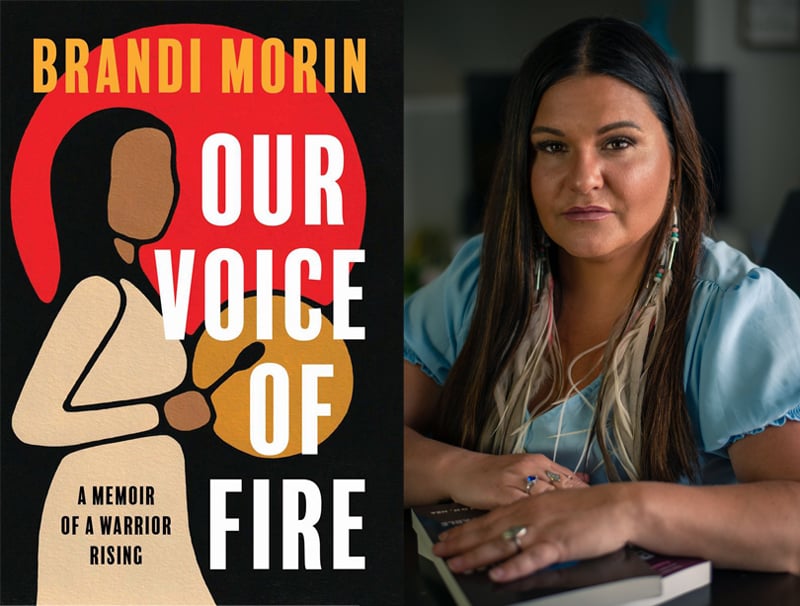Brandi Morin opens her debut memoir, Our Voice of Fire: A Memoir of a Warrior Rising, with her visit, along with a New York Times reporter and photographer, to the home of Tina Fontaine’s great-aunt Thelma Favel for a piece on Missing and Murdered Indigenous Women and Girls (MMIWG).
Tina Fontaine was the 15-year-old Sagkeeng First Nations girl whose body was found in Winnipeg’s Red River in 2014, and her murder ignited the MMIWG movement. Sitting in the girl’s great-aunt’s home, Morin realized that she herself could have easily gone missing and been murdered.
Morin, a French/Cree/Iroquois journalist from Treaty 6 territory in Alberta, has made a name for herself in journalism, with stories for Al Jazeera, National Geographic, Aboriginal Peoples Television Network, and the CBC, reporting on Indigenous news with a level of care and understanding that is often lacking elsewhere.
In Our Voice of Fire, out this month from House of Anansi Press, Morin weaves together behind-the-scenes moments from her career with her difficult personal experiences, which include growing up in foster care, bouts with substance use, witnessing generational trauma, and experiencing mental health crises and sexual abuse.
She chose to reveal her past as a survivor to inspire others and show that they’re not alone. Morin’s friend and former APTN colleague Karen Pugliese had encouraged her for years to tell her story. When she finally felt ready to share it, she knew it would be empowering – both for herself and readers.
“What I try to do in my storytelling is humanizing, because that’s what’s been missing a lot,” she says. “I always wanted [the memoir] to intertwine with this work, just so people understand the passion behind it.”
Our Voice of Fire describes the evolution of Morin’s journalism career. She had no experience but was determined from the beginning – she pushed the Stony Plain Reporter/Spruce Grove Examiner to launch an Indigenous-focused feature written by her.
“I didn’t have that training in journalism school. I just kind of went out and connected with people and did these stories,” she says. “I didn’t know that you’re not supposed to connect with their hearts, I just do it. And I could not do it any other way.”
Her memoir also includes what it was like to produce her heartbreaking work for National Geographic, covering the return of the remains of nine Lakota children from the Pennsylvania-based Carlisle Indian Industrial School, a residential school, to their home community of Rosebud Sioux Reservation in South Dakota in 2021.
Revealing her personal hardships feels like an act of reciprocity for all the stories people have shared with her for her work, but it hasn’t been easy.
“It’s nerve wracking, because it is so intimate,” Morin says. “You have to dig deep, deep, deep … but people share their most intimate stories with me all the time.”
The care that Morin puts into her journalism takes various shapes throughout her book – she advocated for a content warning ahead of one chapter and the inclusion of various help line numbers at the end of Our Voice of Fire for those who have experienced sexual violence.
It wasn’t standard for Anansi to put this information in a book, but it was important to Morin to include them. “People don’t know, or they’re way out on the rez and don’t know how to connect with different resources,” she says.
If you read any of Morin’s journalism, or spend more than five minutes with her, it’s evident that she cares deeply about people. It’s unsurprising, then, that while she’s exposing the deepest and hardest moments of her life, she’s looking to support others as they engage with her writing. Morin makes it clear she’s only here because of the unrelenting support and love from her parents, her kohkum, her family, and friends.
“There were always people that would just show up in my life and either pray for me or [help],” she says. “I’m really grateful for that, because I know a lot of people don’t have that.”
Morin reflects back on Tina Fontaine. Including her and her great-aunt in Our Voice of Fire is an act of honouring her and giving MMIWG a face and a name for all of Canada to see and hear.
“This is not just my story. It’s our story.”

 Contact us via email
Contact us via email
